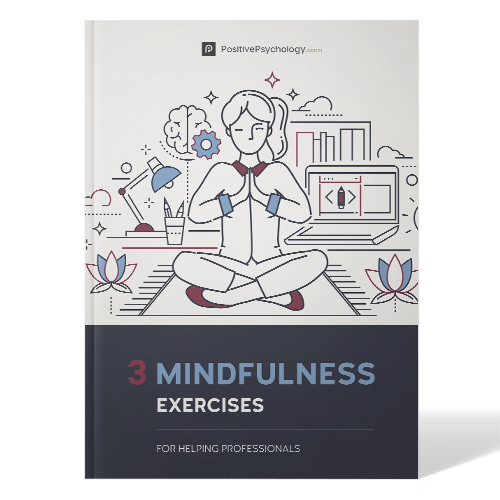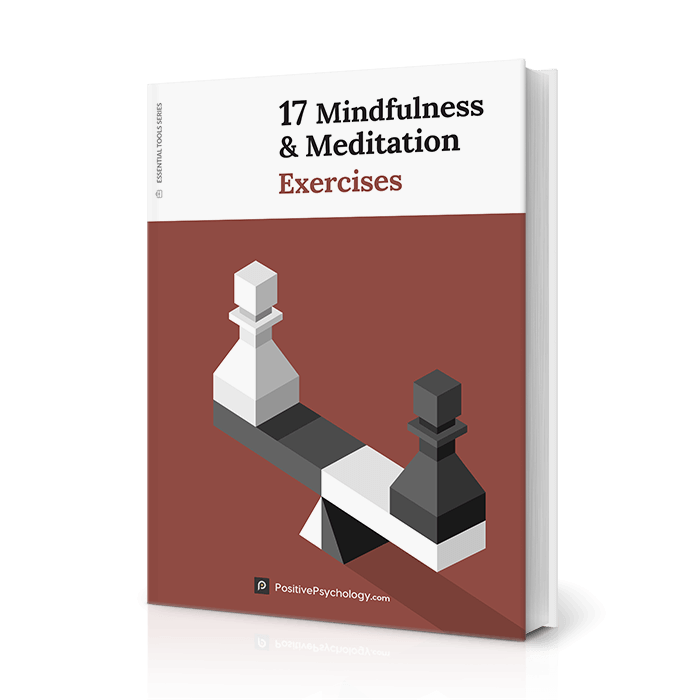The Five Facet Mindfulness Questionnaire (FFMQ)
 In this article, we will have a look at the Five Facet Mindfulness Questionnaire, which is an objective test on mindfulness and its impact on the vital aspects of life.
In this article, we will have a look at the Five Facet Mindfulness Questionnaire, which is an objective test on mindfulness and its impact on the vital aspects of life.
It is a brief but in-depth study on the analysis with some great online resources and evidence-supported explanations of how the test works in real life.
Before you read on, we thought you might like to download our three Mindfulness Exercises for free. These science-based, comprehensive exercises will not only help you cultivate a sense of inner peace throughout your daily life but will also give you the tools to enhance the mindfulness of your clients, students, or employees.
This Article Contains:
A Quick Mindfulness Recap
Mindfulness is the connecting bridge between our mind and the present moment.
It is the art of staying aware of what is happening right now, what we are thinking about this very moment, and how we are feeling at present.
Jon Kabat Zinn, the proponent and one of the most eminent figures in the field of applied mindfulness, defined it as a process of being involved and accepting the internal and external moment-to-moment experience in a decentered manner (Kabat-Zinn, 1994).
Mindfulness is secular in every aspect, which is why different branches of mental health interventions have embraced mindful practices for enhancing wellbeing (Ludwig & Kabat-Zinn, 2008). As practical measures of mindfulness, there are two most popular techniques that many psychologists and health professionals use today:
- Mindfulness-Based Stress Reduction Techniques (MBSR) for helping people get rid of burnout and establish a deeper connection to their mind and body.
- Mindfulness-Based Cognitive Therapy (MBCT) that helps people catch the negative automatic thoughts that cause stress and allows them to successfully replace them with positive and self-enhancing thinking (Segal, Teasdale, Williams, & Gemar, 2002).
All formal and informal mindfulness-based practices aim to:
- Alleviate stress.
- Promote positive thinking.
- Develop a deep and meaningful insight.
- Prevent breakdown from anxiety and distress.
- Help people recover from chronic physical illnesses.
- Develop robust coping mechanisms and build emotional resilience.
Studies have found that mindfulness is effective and offers a permanent solution to adverse mental health conditions such as depression, PTSD, postpartum diseases, and substance abuse.
Besides recovery, it also reduces the chances of relapse, which is another reason behind the immense popularity of mindfulness-based practices (Chiesa & Serretti, 2009; Hofmann, Sawyer, Witt, & Oh, 2010; Piet & Hougaard, 2011; Strauss, Cavanagh, Oliver, & Pettman, 2014).
What is the Five Facet Mindfulness Questionnaire?

- observation
- description
- aware actions
- non-judgmental inner experience, and
- non-reactivity.
The test consists of 39 items that measure the five facets, and the scores provide an estimate of where we stand in terms of mindfulness and self-awareness.
Besides assessing how we are, the Five Facet Mindfulness Questionnaire also provides an accurate judgment of the impact of any previous mindful practices that we have practiced before. The development of this questionnaire was crucially important as it was one of the earliest measures that explored the efficacy of mindfulness in overcoming real-life problems (Baer, Smith, & Allen, 2004).
The original long-form version of the Five Facet Mindfulness Questionnaire contains 39 statements that relate to our thoughts, experiences, and actions in daily life. Ruth Baer, a professor and mindfulness researcher, based at the Kentucky University, developed this scale along with her team, to measure the factors that help us stay mindful in daily life.
The test originates from an exploratory analysis of similar tests such as the Mindfulness Attention Awareness Scales (Brown & Ryan, 2003), Cognitive Affective Mindfulness Scale (Hayes & Feldman, 2004), Kentucky Inventory of Mindfulness Skills (Baer et al., 2004), and Freiburg Mindfulness Inventory (Walach, Buchheld, Buttenmüller, Kleinknetch, & Schmidt, 2006).
Each of the five facets of the FFMQ provides a closer look at our inner faculties. The overall scores of all five subscales of the FFMQ give a reliable measure of self-awareness and suggest how effective mindfulness practices have proved to us.
What Versions Are There? Short and Long Form?
The Five Facet Mindfulness Scale that Baer developed was incorporated in different languages and forms.
The original assessment consisted of 39 self-scorable statements, each investigating one of the five main aspects (observing, describing, acting with awareness, nonreactivity, and non-judgment).
Some shorter versions of the tests in other languages also became popular. They used a system known as the Rasch analysis to measure the outcome of the results and predict their implications. The smaller subscales of the test consisted around 18-24 items that were selected after eliminating statements that researchers felt were inappropriate for the particular population (Baer, Carmody, & Hunsinger, 2012).
Subscales of this test include:
- A Dutch version with 24 items (FFMQ – Short Form).
- A German version consisting of 20 statements (FFMQ – Short).
- A Chinese version with 20 statements.
The short and long forms of the FFMQ test are useful for comparing different mindful interventions and predicting which technique is ideal for a particular mental health condition. The scales are recommended for comparing pre and post interventions and estimating the level of mindfulness of subjects at present (Medvedev, Titkova, Siegert, Hwang, & Krägeloh, 2018; Tran, Glück, & Nader, 2013).
The Five Facet Mindfulness Scale consists of positive and negative worded statements that hold for practitioners and beginners. Baer and other professionals working on the test admit that both the short and long versions of the test are helpful for clinical and non-clinical population across cultures.
The shorter subscales have an advantage of quicker administration and can be applied to a large sample population. However, the extended version provides a detailed explanation of the scores and is a more reliable predictor of wellbeing.
United in strengths – five facets of mindfulness – VIAStrengths
What Does the FFMQ Measure?
As mentioned earlier, the FFMQ is a mindfulness-based intervention that tests whether mindfulness is related to a decrease in clinical symptoms of depression, anxiety, and stress.
The scale also measures the effectiveness of other mindfulness strategies such as MBCT and MBSR and establish their role in individual wellbeing (Baer, Smith, Hopkins, Krietemeyer, & Toney, 2006).
Recent studies are also investigating the psychometric characteristics of the short and long versions (FFMQ- SF, and FFMQ-LF) to support the association between the test and other MBIs (Mindfulness-Based Interventions; Baer et al., 2006; Neff, 2003).
The 39 items of the original questionnaire measure five vital elements of mindfulness. Responses in the scale are made on a 5-point Likert Scale, and the summation of the direct and reverse-scored items give the total score.
The five facets, or five key aspects of mindfulness that the test measures acts as the mediator of therapeutic change and mindful interventions (Carmody & Baer, 2008).
Below is a brief description of the five factors that this test measures:
1. Observation
Observation entails in the ways we use our sensory awareness. It involves how we see, feel, and perceive the internal and external world around us and select the stimuli that require our attention and focus.
2. Description
The statements evaluating descriptive qualities study the way we label our experiences and express them in words to ourselves and others.
3. Mindful actions
Mindfulness is closely related to self-awareness and calculated actions. This facet of the test studies the movements we choose after attending to the information present at the moment. It delves deep into whether we can act out of quick judgment and get out of the autopilot mode before responding to a situation.
4. Non-judgmental inner experience
Non-judgmental experience is tied in with not letting the inner critic take a toll on our happiness and positive state of mind. It calls for self-acceptance and unconditional empathy for oneself and others.
5. Non-reactivity
This aspect refers to active detachment from negative thoughts and emotions so that we can accept their existence and choose not to react to them. Non-reactivity makes way for emotional resilience and restores mental balance (McManus, Surawy, Muse, Vazquez-Montes, & Williams, 2012).
Scoring and Interpretation

There are two patterns of scoring involved in the Five Facet Mindfulness Test:
- Direct Scoring – where the items are scored according to the Likert value (for example 1 would add a score of 1 and 4 adds a value of 4).
- Reverse Scoring – where we score the items backward (for example, 1 adds a score of 5, 5 adds a score of 1, 4 would mean a score of 2, and likewise).
The items marked R are reverse scored. Summation of all the direct and reverse items adds up to the total value of the scale. They are negatively worded statements (for example – I don’t care what I am doing because I am distracted in day-dreaming, overthinking, or otherwise).
Here is a breakdown of all the statements of the long-form FFMQ questionnaire and what aspect they measure:
| Facet | Statements that measure it | Scoring Pattern |
|---|---|---|
| 1. Observation | 1, 6, 11, 15, 20, 26, 31, 36 | All directly scored |
| 2. Description | 2, 7, 12, 16, 22, 27, 32, 37 | 12, 16, and 22 – Reverse Items |
| 3. Aware actions | 5, 8, 13, 18, 23, 28, 34, 38 | All reverse-scored items |
| 4. Non-judgmental inner critic | 3, 10, 14, 17, 25, 30, 35, 39 | All reverse-scored items |
| 5. Non-reactivity | 4, 9, 19, 21, 24, 29, 33 | All directly scored items |
Gu and colleagues (2016) created a shorter version of the test, the FFMQ-SF that had 15 items from the original Five Facet Questionnaire. Although there were arguments about the validity of the abridged form, researchers believed that the 15 statements included in it serve the test’s purpose as accurately as the original version.
The items and the scoring of the shorter adaptation are shown below:
| Facet | Statements that measure it | Scoring Pattern |
|---|---|---|
| Observation | 1, 6, 11 | Direct |
| Description | 2, 7, 12 | 7 – Reversed Scoring |
| Aware actions | 3, 8, 13 | Reverse |
| Non-judgmental experience | 4, 9, 14 | Reverse |
| Non-reactivity | 5, 10, 15 | Direct |
A Look at the Validity
Evaluation of the psychological implications of the scale revealed that FFMQ has strong validity. Repeated administration of the test pointed at high test-retest reliability and internal consistency of the assessment; both for the long-form and shorter versions of it.
Studies on a large-scale population including students, professionals, and clinically depressed individuals proved that FFMQ is a predictor for positive thinking, an overall uplifted mood, and subjective feelings of wellbeing (Baer et al., 2006; Bohlmeijer, Ten Klooster, Fledderus, Veehof, & Baer, 2011).
Furthermore, research on regular meditators and non-meditators who took the test indicated that regular practitioners had higher scores than non-meditators, proving the direct positive correlation between meditation and mindfulness (Bohlmeijer et al., 2011).
Construct validity, which is ideally one of the biggest concerns of psychometrists for proving the usefulness of a scale, is relatively high and stable for this test across cultures and different age groups (Crocker & Algina, 1986). Construct validation of the analysis offered substantial value to its definition and application. It standardized the results and asserted their efficacy for predicting mindful self-awareness (Levinson, Stoll, Kindy, Merry, & Davidson, 2014).
Dr. Ruth Baer conducted a factor analysis of the five facets of FFMQ in 2006. Her studies revealed that the hierarchical structure of the factors justify the traits that each element claims to measure (Baer et al., 2006; Baer et al., 2008).
Overall, the Five Facet Mindfulness Questionnaire is an established and valid psychometric self-assessment for mindfulness. The five subscales of the test provide a meaningful estimate of how aware the respondent is at the moment. Besides, they also assess the impact of the mindful interventions he has undertaken earlier (Campbell & Fiske, 1959).
Where Can I Find it Online?

They are designed in a way that can help individuals irrespective of whether they are undergoing a stressful phase or not. Below is a snippet of what the test looks like. You can also find a detailed description of this test from our Toolkit or take it online.
Based on your general opinion about yourself, rate the following statements as is right for you:
- 1 – Never
- 2 – Rarely True
- 3 – Sometimes True
- 4 – Often True
- 5 – Always True
| Statements | Rate |
|---|---|
| 1. While walking, I am aware of the sensations in my body. | |
| 2. I can describe my feelings well. | |
| 3. I criticize myself for having irrational emotions and thoughts. | |
| 4. I can perceive emotions without reacting to them. | |
| 5. I am easily distracted. | |
| 6. I am aware of the bodily sensations when I take a bath. | |
| 7. I can easily talk about my thoughts and opinions. | |
| 8. I don’t pay attention to my work as I am busy daydreaming most of the time. | |
| 9. I can watch my feelings without getting attached to them. | |
| 10. I correct myself when I think the way I shouldn’t. | |
| 11. I can feel how eating and drinking affect my body and mind. | |
| 12. I find it hard to express what I feel. | |
| 13. I am easily distracted. | |
| 14. I am aware that some of my thoughts are not normal, and I know that I shouldn’t feel that way. | |
| 15. I can feel pure sensations like the wind or the sunlight touching my skin. | |
| 16. Sometimes I cannot find words to express what I feel. | |
| 17. I judge my thoughts as good or bad. | |
| 18. I find it difficult to sustain focus. | |
| 19. I step back when I catch myself thinking something negative or distressing. | |
| 20. I can pay attention to the clock ticking, birds chirping, and cars passing. | |
| 21. I think before reacting under stressful situations. | |
| 22. I find it difficult to describe my bodily sensations in words. | |
| 23. I sometimes feel that I am not in complete awareness of myself. | |
| 24. I can calm down soon after experiencing distressing thoughts and impulses. |
A Take-Home Message
Mindfulness interventions or tests do not offer immediate relief, and neither do they guarantee a quick solution to distress. What they provide us is the reassurance that we are doing great and can keep any unwanted thoughts from de-persuading us.
The five aspects of awareness that the FFMQ investigates help in:
- Clarifying goals.
- Accepting negative thoughts but not reacting to them.
- Cultivating openness and awareness of mind and body.
- Dealing with stress and adversities.
- Expressing and regulating emotions.
- Problem-solving and decision-making.
- Nurturing positive relationships.
The key to mindful living lies in observing everything and attending only to the positivity around. To quote Carl Gustav Jung:
It all depends on how we look at things, and not how they are in themselves.
We hope you enjoyed reading this article. Don’t forget to download our three Mindfulness Exercises for free.
- Baer, R. A., Carmody, J., & Hunsinger, M. (2012). Weekly change in mindfulness and perceived stress in a mindfulness-based stress reduction program. Journal of Clinical Psychology, 68(7), 755-765.
- Baer, R. A., Smith, G. T., & Allen, K. B. (2004). Assessment of mindfulness by self-report: The Kentucky Inventory of Mindfulness Skills. Assessment, 11(3), 191-206.
- Baer, R. A., Smith, G. T., Hopkins, J., Krietemeyer, J., & Toney, L. (2006). Five Facet Mindfulness Questionnaire. Assessment, 13, 27-45.
- Baer, R. A., Smith, G. T., Lykins, E., Button, D., Krietemeyer, J., Sauer, S., … & Williams, J. M. G. (2008). Construct validity of the five facet mindfulness questionnaire in meditating and nonmeditating samples. Assessment, 15(3), 329-342.
- Bohlmeijer, E., Ten Klooster, P. M., Fledderus, M., Veehof, M., & Baer, R. (2011). Psychometric properties of the five facet mindfulness questionnaire in depressed adults and development of a short form. Assessment, 18(3), 308-320.
- Brown, K. W., & Ryan, R. M. (2003). The benefits of being present: Mindfulness and its role in psychological well-being. Journal of Personality and Social Psychology, 84(4), 822-848.
- Campbell, D. T., & Fiske, D. W. (1959). Convergent and discriminant validation by the multitrait-multimethod matrix. Psychological Bulletin, 56(2), 81-105.
- Carmody, J., & Baer, R. A. (2008). Relationships between mindfulness practice and levels of mindfulness, medical and psychological symptoms and well-being in a mindfulness-based stress reduction program. Journal of Behavioral Medicine, 31(1), 23-33.
- Chiesa, A., & Serretti, A. (2009). Mindfulness-based stress reduction for stress management in healthy people: A review and meta-analysis. The Journal of Alternative and Complementary Medicine, 15(5), 593-600.
- Crocker, L., & Algina, J. (1986). Introduction to classical and modern test theory. Orlando, FL: Holt, Rinehart and Winston.
- Gu, J., Strauss, C., Crane, C., Barnhofer, T., Karl, A., Cavanagh, K., & Kuyken, W. (2016). Examining the factor structure of the 39-item and 15-item versions of the Five Facet Mindfulness Questionnaire before and after mindfulness-based cognitive therapy for people with recurrent depression. Psychological Assessment, 28(7), 791-802.
- Hayes, A. M., & Feldman, G. (2004). Clarifying the construct of mindfulness in the context of emotion regulation and the process of change in therapy. Clinical Psychology: Science and Practice, 11(3), 255-262.
- Hofmann, S. G., Sawyer, A. T., Witt, A. A., & Oh, D. (2010). The effect of mindfulness-based therapy on anxiety and depression: A meta-analytic review. Journal of Consulting and Clinical Psychology, 78(2), 169-183.
- Kabat-Zinn, J. (1994). Wherever you go, there you are: Mindfulness meditation in everyday life. New York, NY: Hyperion Books.
- Levinson, D. B., Stoll, E. L., Kindy, S. D., Merry, H. L., & Davidson, R. J. (2014). A mind you can count on: Validating breath counting as a behavioral measure of mindfulness. Frontiers in Psychology, 5, 1202.
- Ludwig, D. S., & Kabat-Zinn, J. (2008). Mindfulness in medicine. Jama, 300(11), 1350-1352.
- McManus, F., Surawy, C., Muse, K., Vazquez-Montes, M., & Williams, J. M. G. (2012). A randomized clinical trial of mindfulness-based cognitive therapy versus unrestricted services for health anxiety (hypochondriasis). Journal of Consulting and Clinical Psychology, 80(5), 817.
- Medvedev, O. N., Titkova, E. A., Siegert, R. J., Hwang, Y. S., & Krägeloh, C. U. (2018). Evaluating short versions of the Five Facet Mindfulness Questionnaire using Rasch analysis. Mindfulness, 9(5), 1411-1422.
- Neff, K. D. (2003). The development and validation of a scale to measure self-compassion. Self and Identity, 2(3), 223-250.
- Piet, J., & Hougaard, E. (2011). The effect of mindfulness-based cognitive therapy for prevention of relapse in recurrent major depressive disorder: A systematic review and meta-analysis. Clinical Psychology Review, 31(6), 1032-1040.
- Segal, Z. V., Teasdale, J. D., Williams, J. M., & Gemar, M. C. (2002). The mindfulness-based cognitive therapy adherence scale: Inter‐rater reliability, adherence to protocol and treatment distinctiveness. Clinical Psychology & Psychotherapy, 9(2), 131-138.
- Strauss, C., Cavanagh, K., Oliver, A., & Pettman, D. (2014). Mindfulness-based interventions for people diagnosed with a current episode of an anxiety or depressive disorder: A meta-analysis of randomised controlled trials. PLOS ONE, 9(4).
- Tran, U. S., Glück, T. M., & Nader, I. W. (2013). Investigating the Five Facet Mindfulness Questionnaire (FFMQ): Construction of a short form and evidence of a two‐factor higher order structure of mindfulness. Journal of Clinical Psychology, 69(9), 951-965.
- Walach, H., Buchheld, N., Buttenmüller, V., Kleinknecht, N., & Schmidt, S. (2006). Measuring mindfulness—the Freiburg mindfulness inventory (FMI). Personality and Individual Differences, 40(8), 1543-1555.
Let us know your thoughts
Read other articles by their category
- Body & Brain (49)
- Coaching & Application (57)
- Compassion (26)
- Counseling (51)
- Emotional Intelligence (24)
- Gratitude (18)
- Grief & Bereavement (21)
- Happiness & SWB (40)
- Meaning & Values (26)
- Meditation (20)
- Mindfulness (45)
- Motivation & Goals (45)
- Optimism & Mindset (34)
- Positive CBT (28)
- Positive Communication (20)
- Positive Education (47)
- Positive Emotions (32)
- Positive Leadership (18)
- Positive Parenting (4)
- Positive Psychology (33)
- Positive Workplace (37)
- Productivity (16)
- Relationships (46)
- Resilience & Coping (36)
- Self Awareness (21)
- Self Esteem (37)
- Strengths & Virtues (31)
- Stress & Burnout Prevention (34)
- Theory & Books (46)
- Therapy Exercises (37)
- Types of Therapy (64)





What our readers think
Hello,
What is the score range for high, medium or low?
Thank You.
Hi Nilaskhi,
The interpretation of scores as high, medium, or low mindfulness can vary depending on the specific research study or clinical context.
Scores for each facet are calculated by summing the scores on items related to that facet. Higher scores indicate higher levels of the facet of mindfulness being measured.
I hope this answers your question 🙂
Warm regards,
Julia | Community Manager
Hello,
Kindly give me Dr. Baer’s email to get a permission to use the Five Facet Mindfulness Questionnaire.
Thanks,
Feliciana
Hey, will you please provide me the email of Baer (author of Five facet mindfulness scale), so that I will take his permission to use this scale in my research project.
Thanks!
Hi Maryam,
you can contact Dr. Baer here.
I hope this helps 🙂
Warm regards,
Julia | Community Manager
Hello!
How can I understand what results are normal or nor normal?
Thanx
Hi Tatiana,
To determine what results are “normal” or “not normal”, it’s essential to consider the context in which the questionnaire is used. Typically, higher scores on the FFMQ indicate greater mindfulness. However, it’s crucial to interpret scores in relation to the individual’s context, background, and the purpose of the assessment.
I hope this helps!
Kind regards,
Julia | Community Manager
Hello,
Is there a French version of this scale?
Best regards,
Marion TROCHET
Hi Marion,
yes, the scale also exists in a translated version. You can find it here.
Hope this helps!
Kind regards,
Julia | Community Manager